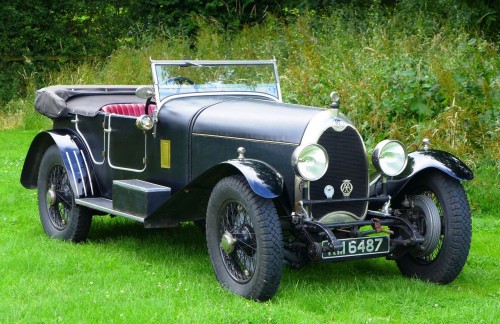
Click Here for Full Screen Image - Click Here to Download Image
 |  |  |  |  | |||||
 |  |  |
| Lot number | 97 |
|---|---|
| Hammer value | N/S (est. £95,000 - £110,000) |
| Description | HE 16/60 Short Chassis Sports Tourer |
| Registration | RM 6487 |
| Year | 1929 |
| Colour | Black |
| Engine size | 2,290 cc |
| Chassis No. | HEC6035 |
| Engine No. | HE6035 |
The HE was one of a number of high quality fast tourers that came to market after World War One.
Produced in limited numbers from their workshops in Wolsey Road, Caversham, Reading, by the Herbert Engineering Co Ltd, the HE offered lusty performance and very handsome sporting bodywork – at considerable cost. The low production volumes and bespoke nature of the cars meant that prices were very high, with HEs in the early ‘20s selling for little less than a Bentley.
Designed by talented engineer Roland Sully (who coincidentally had a business in Hereford), the first cars had conventional 4-cylinder side-valve engines with separate 4-speed gearboxes and an overhead worm-drive rear axle. Engine capacities were soon increased to just over two-litres with some 40bhp available, the attractive lightweight sports model with gorgeous ‘Dutch clog’ bodywork being good for 75mph.
As with most small manufacturers who were competing for a slice of the luxury car market, a 6-cylinder was soon added to the range - in this case a 2.3-litre straight six engine.. The 15.7HP 16/55 was joined in 1929 by the short chassis 16/60 Sports model whose triple carbs and close ratio gearbox made it good for 80mph. Only three such Sports models are thought to have been made out of a total of 61 sixes.
Fitted with a number of interesting 'goodies', its brakes are geared and servo assisted, as well as having a hinged foot-pad at the top of the brake pedal which, if tilted forwards at the top, pulls a bowden cable attached to the rear of the pad which opens a valve extracting manifold pressure to increase the effectiveness of the servo. Although still fitted to the car, it is not connected by preference of the owner. It also has a Hele-Shaw multi-disc clutch, adjustable steering column (admittedly requiring a spanner) and a fuel reserve switch operated from the bulkhead. A Clayton de Wandre steering mechanism was also standard equipment.
Contemporary HE advertisements boasted, ‘The best of British Sixes of exceptional design whereby the greatly desired features of a semi-sporting car are linked with the luxury and silky running of a town carriage’. The company were also sufficiently confident in their product to offer a five-year guarantee, although how owners got on after the firm succumbed to financial pressures in 1931 is anyone's guess.
This car is believed to be the sole remaining short chassis 16/60. Pictured in ‘Georgano’ (where it is incorrectly captioned as a 16/55), its whereabouts was known in the mid-1950s when it was campaigned by a Major Woolston. He had the car shipped to New York and drove it across the US covering 5,000 trouble-free miles. It then returned to the Phoenix Garage at Hartley Wintney (the birthplace of the VSCC) where it lived behind the pub.
It was subsequently purchased by well-known VSCC member, Julian Hallam, from Stanley Mann, the Bentley dealer, in the 1980s. By 1990 he had decided to move on to other projects and advertised the car in The Automobile where it was spotted by the vendor. Having acquired the car, he embarked on a program of improvements.
By good fortune, the late Denis de Ferranti, the well known collector, had acquired one of the five remaining long chassis HE Sixes to sit alongside his Napiers, Bugattis and other exotica. He had already commissioned patterns for a new cylinder head casting and so, in the interests of longevity, the vendor was able to have a new one cast by a Wolverhampton foundry, getting the finished article X-rayed to ensure that it was sound. The rest of the engine was fully rebuilt and bored out to 2.5-litres by Hereford Rebore, and the car has covered less than 2,000 miles since.
Thanks to another piece of good fortune, he was also able to acquire another HE Six gearbox, especially useful as the one that came with the car was worn in part. The close ratio gearbox was carefully rebuilt, along with a new crown-wheel and pinion for the Salisbury back axle; the mechanical elements of the car were finally back to full health with its triple-carburettors, an SU pump (the original Autovac is still in situ) and a full-flow oil filter for reliability.
The final jobs were to have the hood frame retrimmed in double-duck along with a set of side screens which have yet to be used. The 20" wheels were checked by Richards Brothers of Cardiff, re-spoked as necessary and fitted with excellent Michelin tyres.
The vendor has been the custodian of this HE Six for some 24 years and has loved it and used it regularly. It is only very reluctantly being offered for sale due to health issues brought on by advancing years. This is probably your only chance to acquire one of these imposing sports-tourers, this being the rarest of the them all and available at much less than the cost of a 3 litre Bentley or Vauxhall 30/98.